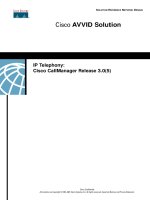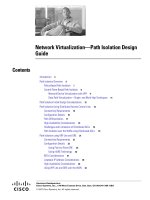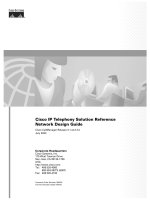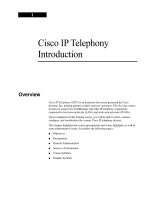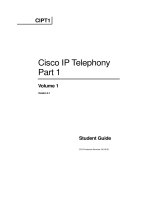Cisco IP Telephony Solution Reference Network Design Guide
Bạn đang xem bản rút gọn của tài liệu. Xem và tải ngay bản đầy đủ của tài liệu tại đây (5.93 MB, 334 trang )
Corporate Headquarters
Cisco Systems, Inc.
170 West Tasman Drive
San Jose, CA 95134-1706
USA
Tel: 408 526-4000
800 553-NETS (6387)
Fax: 408 526-4100
Cisco IP Telephony Solution Reference
Network Design Guide
Cisco CallManager Release 3.1 and 3.2
July 2003
Customer Order Number: 956378
Text Part Number: EDCS-197018
THE SPECIFICATIONS AND INFORMATION REGARDING THE PRODUCTS IN THIS MANUAL ARE SUBJECT TO CHANGE WITHOUT NOTICE. ALL
STATEMENTS, INFORMATION, AND RECOMMENDATIONS IN THIS MANUAL ARE BELIEVED TO BE ACCURATE BUT ARE PRESENTED WITHOUT
WARRANTY OF ANY KIND, EXPRESS OR IMPLIED. USERS MUST TAKE FULL RESPONSIBILITY FOR THEIR APPLICATION OF ANY PRODUCTS.
THE SOFTWARE LICENSE AND LIMITED WARRANTY FOR THE ACCOMPANYING PRODUCT ARE SET FORTH IN THE INFORMATION PACKET THAT
SHIPPED WITH THE PRODUCT AND ARE INCORPORATED HEREIN BY THIS REFERENCE. IF YOU ARE UNABLE TO LOCATE THE SOFTWARE LICENSE
OR LIMITED WARRANTY, CONTACT YOUR CISCO REPRESENTATIVE FOR A COPY.
The Cisco implementation of TCP header compression is an adaptation of a program developed by the University of California, Berkeley (UCB) as part of UCB’s public
domain version of the UNIX operating system. All rights reserved. Copyright © 1981, Regents of the University of California.
NOTWITHSTANDING ANY OTHER WARRANTY HEREIN, ALL DOCUMENT FILES AND SOFTWARE OF THESE SUPPLIERS ARE PROVIDED “AS IS” WITH
ALL FAULTS. CISCO AND THE ABOVE-NAMED SUPPLIERS DISCLAIM ALL WARRANTIES, EXPRESSED OR IMPLIED, INCLUDING, WITHOUT
LIMITATION, THOSE OF MERCHANTABILITY, FITNESS FOR A PARTICULAR PURPOSE AND NONINFRINGEMENT OR ARISING FROM A COURSE OF
DEALING, USAGE, OR TRADE PRACTICE.
IN NO EVENT SHALL CISCO OR ITS SUPPLIERS BE LIABLE FOR ANY INDIRECT, SPECIAL, CONSEQUENTIAL, OR INCIDENTAL DAMAGES, INCLUDING,
WITHOUT LIMITATION, LOST PROFITS OR LOSS OR DAMAGE TO DATA ARISING OUT OF THE USE OR INABILITY TO USE THIS MANUAL, EVEN IF CISCO
OR ITS SUPPLIERS HAVE BEEN ADVISED OF THE POSSIBILITY OF SUCH DAMAGES.
Cisco IP Telephony Solution Reference Network Design Guide
Copyright © 2002, Cisco Systems, Inc.
All rights reserved.
CCIP, CCSP, the Cisco Arrow logo, the Cisco Powered Network mark, Cisco Unity, Follow Me Browsing, FormShare, and StackWise are trademarks of Cisco Systems, Inc.;
Changing the Way We Work, Live, Play, and Learn, and iQuick Study are service marks of Cisco Systems, Inc.; and Aironet, ASIST, BPX, Catalyst, CCDA, CCDP, CCIE, CCNA,
CCNP, Cisco, the Cisco Certified Internetwork Expert logo, Cisco IOS, the Cisco IOS logo, Cisco Press, Cisco Systems, Cisco Systems Capital, the Cisco Systems logo,
Empowering the Internet Generation, Enterprise/Solver, EtherChannel, EtherSwitch, Fast Step, GigaStack, Internet Quotient, IOS, IP/TV, iQ Expertise, the iQ logo, iQ Net
Readiness Scorecard, LightStream, MGX, MICA, the Networkers logo, Networking Academy, Network Registrar, Packet, PIX, Post-Routing, Pre-Routing, RateMUX, Registrar,
ScriptShare, SlideCast, SMARTnet, StrataView Plus, Stratm, SwitchProbe, TeleRouter, The Fastest Way to Increase Your Internet Quotient, TransPath, and VCO are registered
trademarks of Cisco Systems, Inc. and/or its affiliates in the U.S. and certain other countries.
All other trademarks mentioned in this document or Web site are the property of their respective owners. The use of the word partner does not imply a partnership relationship
between Cisco and any other company. (0304R)
iii
Cisco IP Telephony Solution Reference Network Design Guide
EDCS-197018
CONTENTS
Preface
xiii
Purpose
xiii
Scope
xiii
Audience
xiii
Organization
xiii
Obtaining Documentation
xv
World Wide Web
xv
Documentation CD-ROM
xv
Ordering Documentation
xv
Documentation Feedback
xv
Obtaining Technical Assistance
xvi
Cisco.com
xvi
Technical Assistance Center
xvi
Cisco TAC Web Site
xvii
Cisco TAC Escalation Center
xvii
CHAPTER
1
Overview of Cisco AVVID IP Telephony Solutions
1-1
Why IP Telephony?
1-1
Architecture Overview
1-3
Security
1-4
Quality of Service
1-4
Network Management
1-4
Cisco CallManager Deployment Models
1-5
Single-Site Call Processing Model
1-5
Multi-Site WAN Model with Centralized Call Processing
1-5
Multi-Site WAN Model with Distributed Call Processing
1-6
Clustering Over the IP WAN
1-6
Applications
1-7
Cisco IP SoftPhone
1-7
Extension Mobility
1-7
Multi-Party Voice Conferencing
1-8
Unified Messaging
1-8
Web Services for IP Phones
1-8
Cisco Personal Assistant
1-9
Contents
iv
Cisco IP Telephony Solution Reference Network Design Guide
EDCS-197018
Cisco Customer Response Solutions Platform
1-10
Cisco IP Integrated Contact Distribution (IP ICD)
1-10
Cisco IP Interactive Voice Response (IP IVR)
1-11
Components That Apply to All Deployment Models
1-11
Voice, Fax, and Modem Gateways
1-11
Station Devices
1-12
Emergency Services (911 and E911)
1-12
CHAPTER
2
IP Telephony Deployment Models
2-1
Single Site
2-2
Solution Benefits
2-3
Best Practices
2-4
Dial Plan
2-4
Multi-Site WAN with Centralized Call Processing
2-4
Solution Benefits
2-6
Best Practices
2-6
Remote Site Survivability
2-7
Call Admission Control
2-9
Recommendations for Locations and Call Admission Control
2-11
Gateways
2-11
Dial Plan
2-11
Multi-Site WAN with Distributed Call Processing
2-13
Solution Benefits
2-15
Best Practices
2-15
Call Processing Agents
2-15
Call Admission Control
2-16
Dial Plan
2-17
Site Dial Plan
2-18
Gatekeeper Dial Plan
2-20
Hybrid Dial Plan
2-20
Clustering Over the IP WAN
2-21
Local Failover Deployment Model
2-22
Cisco CallManager Provisioning
2-23
Gateways
2-24
Voice Mail
2-24
Music on Hold
2-24
Remote Failover Deployment Model
2-25
Cisco CallManager Provisioning
2-26
Gateways
2-26
Contents
v
Cisco IP Telephony Solution Reference Network Design Guide
EDCS-197018
Voice Mail
2-27
Music on Hold
2-27
CHAPTER
3
Network Infrastructure Requirements for IP Telephony
3-1
LAN Infrastructure
3-3
Traffic Classification
3-4
Interface Queuing
3-4
Bandwidth Provisioning
3-4
WAN Infrastructure
3-5
Bandwidth Provisioning
3-6
Provisioning for Voice Bearer Traffic
3-7
Provisioning for Call Control Traffic with Centralized Call Processing
3-8
Provisioning for Call Control Traffic with Distributed Call Processing
3-10
Traffic Prioritization
3-12
Link Efficiency Techniques
3-13
Traffic Shaping
3-15
CHAPTER
4
Choosing a Cisco IP Telephony Gateway
4-1
Understanding Cisco Gateways
4-1
Cisco Access Analog Gateways
4-1
Cisco Access Digital Trunk Gateways
4-2
Gateway Requirements
4-2
Gateway Protocols
4-2
Selecting the Gateway Protocol
4-3
Gateway Protocol and Core Feature Requirements
4-4
DTMF Relay
4-5
SCCP Gateways
4-5
H.323 Gateways
4-5
MGCP Gateway
4-5
Supplementary Services
4-5
SCCP Gateways
4-6
H.323 Gateways
4-6
MGCP Gateway
4-7
Cisco CallManager Redundancy
4-8
SCCP Gateways
4-8
H.323 Gateways
4-9
MGCP Gateway
4-9
Call Survivability in Cisco CallManager
4-10
Endpoint Rules for Gateway Call Survivability
4-10
Contents
vi
Cisco IP Telephony Solution Reference Network Design Guide
EDCS-197018
Site-Specific Gateway Requirements
4-11
Q.SIG Support
4-12
Site Specific Gateway Features Summary
4-13
Summary
4-16
CHAPTER
5
Transcoding, Conferencing, and MTP Resources
5-1
Media Resource Types
5-1
Media Termination Point (MTP)
5-1
Transcoder
5-2
Unicast Conference Bridge
5-2
MTP and Transcoding Resources
5-3
Software MTP Resources
5-4
Hardware MTP and Transcoding Resources
5-4
Catalyst 4000 MTP and Transcoding Services
5-5
Catalyst 6000 MTP and Transcoding Services
5-5
Cisco Catalyst MTP Constraints
5-6
Cisco VG200 MTP and Transcoding Services
5-7
Cisco ICS 7750 MTP and Transcoding Services
5-7
Provisioning MTP and Transcoding Resources
5-8
Application Scenarios
5-9
Single-Site Deployments
5-10
Multi-Site WAN Deployments with Centralized Call Processing
5-10
Multi-Site WAN Deployments with Distributed Call Processing
5-11
IP PSTN Access
5-12
Conferencing Resources
5-13
Software Conferencing Resources
5-15
Hardware Conferencing Resources
5-16
Catalyst 4000 Conferencing Services
5-16
Catalyst 6000 Conferencing Services
5-17
Cisco VG200 Conferencing Services
5-18
Provisioning Conference Resources
5-19
Application Scenarios
5-19
Single-Site Deployments
5-19
Multi-Site WAN Deployments with Centralized Call Processing
5-19
Multi-Site WAN Deployments with Distributed Call Processing
5-22
CHAPTER
6
Call Processing with Cisco CallManager
6-1
Cluster Operation and Scalability Guidelines
6-1
Device Weights
6-3
Contents
vii
Cisco IP Telephony Solution Reference Network Design Guide
EDCS-197018
Server Memory Requirements
6-7
Intracluster Communication
6-7
Cisco CallManager Redundancy
6-8
Redundancy Group Configuration
6-9
Device Pool Configuration
6-10
Clustering Guidelines
6-12
Intercluster Communication
6-13
Cluster Provisioning for the Campus
6-14
Clusters for Multi-site WAN with Distributed Call Processing
6-16
Clusters for Multi-site WAN with Centralized Call Processing
6-18
The Effects of Network Delay on Call Processing
6-18
Clustering Over the WAN
6-19
WAN Considerations
6-19
Intra-Cluster Communications
6-20
Local Failover Deployment Model
6-21
Remote Failover Deployment Model
6-24
Common Design Guidelines for Clustering over the WAN
6-26
Media Resources
6-33
Survivable Remote Site Telephony (SRST)
6-35
SRST Features and Requirements
6-37
SRST Design Considerations
6-38
SRST with Automated Attendant
6-40
CHAPTER
7
Call Admission Control
7-1
Bandwidth Calculations
7-2
Call Admission Control with Cisco CallManager Locations
7-2
Call Admission Control with a Gatekeeper
7-4
Gatekeeper Operations
7-5
Gatekeeper Discovery
7-5
Registration Process
7-6
Admission Requests
7-7
Disengage Request
7-8
Bandwidth Requests
7-8
Technology Prefix
7-9
E.164 Address Resolution
7-9
ARQ Parsing Order
7-10
Cisco IOS Gatekeeper Commands
7-10
Debug Commands
7-11
Cisco CallManager Configuration
7-11
Contents
viii
Cisco IP Telephony Solution Reference Network Design Guide
EDCS-197018
Gatekeeper Used for Call Admission Control
7-12
Gateway Configuration
7-13
Intercluster Trunk Gateways
7-16
Summary of Call Admission Control
7-18
CHAPTER
8
Dial Plan
8-1
Overview of IP Telephony Dial Plans
8-2
Dial Plan Components and Operation
8-4
External Route Pattern Architecture
8-5
Route Patterns
8-7
Route Lists
8-11
Route Groups
8-14
Devices
8-15
Calling Restrictions
8-16
Partitions
8-16
Calling Search Spaces
8-16
Translation Patterns
8-19
Voice Mail Integration and Cisco CallManager Dial Plans
8-21
Voice Mail Integration via SCCP
8-23
Voice Mail Integration via SMDI
8-23
Dial Plan Guidelines for IP Telephony Deployment Models
8-25
Single-Site Deployment
8-26
Multi-Site IP WAN with Distributed Call Processing
8-28
Route Pattern Structure
8-29
Partitions and Calling Search Spaces
8-30
Multi-Site IP WAN with Centralized Call Processing
8-30
Route Pattern Structure
8-31
Partitions and Calling Search Spaces
8-32
Multi-Site IP WAN with Overlapping Extensions
8-33
Partitions and Calling Search Spaces
8-34
Outbound Calls
8-35
Inter-Site Calls
8-35
Incoming Calls
8-36
Voice Mail Considerations
8-36
CHAPTER
9
Voice Mail Integration with Cisco CallManager
9-1
Cisco CallManager and Voice Mail
9-1
Existing Versus New Voice Mail Systems
9-4
Voice Mail and Cisco CallManager Release 3.2
9-6
Contents
ix
Cisco IP Telephony Solution Reference Network Design Guide
EDCS-197018
Cisco Unity
9-7
Cisco Digital PBX Adapter (DPA)
9-9
Understanding How the DPA Works
9-10
Why is the DPA Needed?
9-10
Can I Just Use SMDI?
9-10
What If I Cannot Use SMDI?
9-10
Choosing an Integration Mode
9-11
Using the Simple Integration Mode
9-11
Using the Hybrid Integration Mode
9-12
Using the Multiple Integration Mode
9-13
CHAPTER
10
Migration to an IP Telephony Network
10-1
Network Models
10-1
PBX and Voice Messaging Interfaces and Protocols
10-2
Simple IP Network Migration Sequence
10-3
Reference Models for Migration Configurations
10-5
Detailed Discussion of Model A
10-6
Detailed Discussion of Model B
10-9
Detailed Discussion of Model C
10-11
Detailed Discussion of Model D
10-13
Cisco Digital PBX Adapter (DPA)
10-14
Understanding How the DPA 7630 Works
10-15
Why is the DPA 7630 Needed?
10-15
Can I Just Use SMDI?
10-15
What If I Cannot Use SMDI?
10-15
Choosing an Integration Mode
10-16
Using the Simple Integration Mode
10-16
Using the Hybrid Integration Mode
10-17
Using the Multiple Integration Mode
10-18
CHAPTER
11
CTI Applications Architecture and Design
11-1
Cisco CallManager Application Interfaces
11-1
CTI Architecture
11-3
Cisco CallManager Server
11-3
CTI Application Platform
11-4
CTI Devices
11-4
CTI Manager
11-5
CTI Manager Configuration
11-7
CTI Manager Provisioning
11-8
Contents
x
Cisco IP Telephony Solution Reference Network Design Guide
EDCS-197018
Ensuring Normal Operations
11-12
CTI Redundancy
11-12
CTI Fail-Back
11-14
CTI Design Consideration
11-14
Scalability
11-14
Application Scalability
11-15
Cisco CallManager Scalability
11-15
Grouping CTI devices
11-21
Redundancy
11-22
General Redundancy Considerations
11-22
Redundancy Considerations for Single-Site Call Processing Deployments
11-23
Redundancy Considerations for a Multi-Site WAN with Centralized Call Processing
11-23
Redundancy Considerations for a Multi-Site WAN with Distributed Call Processing
11-25
Quality of Service
11-26
Example of CTI Provisioning for Scalability and Redundancy
11-27
System Profile
11-28
Design Assumptions
11-28
Design Approach
11-29
Identify CTI Resources
11-29
Calculate Package Weights for Each Application
11-29
Group the CTI Devices into Device Pools
11-31
Provision the CTI Resources on the Cisco CallManager and CTI Manager Servers
11-31
Provision Backup Servers for Failover Conditions
11-33
Summary
11-35
CHAPTER
12
Cisco IP IVR System Design Considerations
12-1
IP IVR Architecture
12-1
Cisco CallManager Device Weight Provisioning for IP IVR
12-2
Additional IP-IVR Scalability Considerations
12-3
IP IVR Co-Resident with Cisco CallManager
12-3
Standalone IP IVR Configuration
12-3
Redundancy Considerations
12-4
CTI Manager Fails
12-4
Cisco CallManager Server Fails
12-6
IVR Application Fails
12-6
Summary
12-8
Contents
xi
Cisco IP Telephony Solution Reference Network Design Guide
EDCS-197018
CHAPTER
13
Cisco IP SoftPhone Design Considerations
13-1
Provisioning Guidelines for Cisco IP SoftPhone
13-1
Scalability Considerations
13-3
Example Device Weight Calculation
13-3
Maximum Cisco IP SoftPhone Configuration Limits
13-3
Redundancy Considerations
13-4
Bandwidth Provisioning Considerations
13-6
Call Admission Control
13-6
CHAPTER
14
Directory Access for Cisco IP Telephony Endpoints
14-1
Directory Access and Directory Integration
14-1
Configuring Directory Access
14-3
Directory Access for Cisco IP Phones
14-3
Directory Access for Cisco IP SoftPhone
14-5
Additional References
14-6
CHAPTER
15
Security Recommendations for IP Telephony
15-1
IP Telephony Security Guidelines
15-1
Establish Physical Security
15-2
Protect the Network Elements
15-3
Secure Login Access
15-3
Follow Sound Password and Authentication Practices
15-3
Assign Unique PVID to all 802.1Q Trunking Ports
15-4
Ensure Unused Router Services Are Turned Off
15-4
Securely Configure Network Management Functions
15-4
Use Logging Services to Track Access and Configuration Changes
15-5
Design a Secure IP Network
15-5
Creating and Assigning VLANs and Broadcast Domains
15-5
Implementing Packet Filters
15-7
Directed Broadcasts
15-7
Source-Routed Packets
15-7
IP Spoofing
15-7
ICMP Redirects
15-8
TCP Intercept
15-8
Permitting Other Services
15-8
Protecting the VoIP Gateways
15-10
Firewalls
15-10
Secure the Cisco CallManager Server
15-12
Contents
xii
Cisco IP Telephony Solution Reference Network Design Guide
EDCS-197018
Turn off Unnecessary Services
15-12
Secure the NTFS File System
15-13
Enable System Auditing and Logging
15-14
Configure Certificate Authority
15-15
Secure the IIS Service
15-15
Enable Certificate Authentication Only
15-16
Enable W3C Extended Logging Format
15-16
Clear Indexing
15-16
Remove IIS Virtual Directories
15-16
Remove All Sample Application Directories
15-16
Set Appropriate Virtual Directory Permissions in Web Application Space
15-17
Set Appropriate IIS Log File Permissions
15-17
Set the Security Access Permissions
15-17
Force the Use of HTTPs Only
15-17
Secure the SQL Server
15-18
Use a Separate Group for SQL Server Administration
15-18
Set the SQL Server to Use Windows 2000 Authentication Mode
15-18
Enable SQL Server Auditing
15-18
Remove Any Software MTP and Conferencing Services
15-18
Configure Cisco CallManager SNMP Securely
15-19
Additional References
15-19
CHAPTER
16
Network Management Recommendations for IP Telephony
16-1
Voice Management Overview
16-1
Voice Management Basics
16-1
CiscoWorks Voice Management Tools and Architecture
16-2
CiscoWorks IP Telephony Management Tools
16-2
Cisco Network Management Architecture
16-3
Deployment Considerations
16-4
Cisco CallManager Settings
16-4
System Requirements
16-5
Network Analysis Module Deployment
16-5
CiscoWorks Network Management Best Practices
16-6
Best Practices for Using CiscoWorks LAN Management Solution (LMS)
16-6
Best Practices for Using CiscoWorks VoIP Health Monitor (VHM)
16-7
Best Practices for Using CiscoWorks QoS Policy Manager (QPM)
16-8
Best Practices for Using CiscoWorks Service Level Manager (SLM)
16-8
Best Practices for Using CiscoWorks Internetwork Performance Monitor (IPM)
16-8
Additional References
16-9
xiii
Cisco IP Telephony Solution Reference Network Design Guide
EDCS-197018
Preface
This preface describes the purpose, scope, intended audience, and general organization of this Cisco IP
Telephony Solution Reference Network Design Guide. It also provides information on how to order
documentation from Cisco Systems.
Purpose
This document provides guidelines, recommendations, and best practices to help you design an
IP telephony solution for your enterprise using the Cisco Architecture for Voice, Video, and Integrated
Data (AVVID).
Scope
This document describes the products and features used to build an IP telephony system, and it gives
recommendations on how to combine those elements into an effective solution for your enterprise.
However, this document does not contain specific implementation or configuration details for the
products and features. For details about a particular product or feature, refer to the technical
documentation available online at Cisco.com. (See Obtaining Documentation, page xv.)
Note
Unless stated otherwise, the solution designs presented in this document require Cisco CallManager
Release 3.1 or 3.2, and the information presented here applies only to those releases.
Audience
This document is intended for Cisco customers, partners, and systems engineers who will be designing
and implementing an IP telephony system in the enterprise environment.
Organization
This guide contains the chapters and information listed in the following table.
xiv
Cisco IP Telephony Solution Reference Network Design Guide
EDCS-197018
Preface
Organization
Note
Cisco strongly recommends that you carefully read chapters 1, 2, and 3 before attempting to design an
IP telephony solution and before reading any other sections of this guide.
Chapter Title Description
1 Overview of Cisco AVVID
IP Telephony Solutions
Provides an overview of Cisco AVVID and some of the available Cisco
products for creating an IP telephony solution.
2 IP Telephony Deployment Models Describes the primary models used to deploy an IP telephony solution
and explains when to use each model.
Note
This guide makes frequent references to these deployment
models. Cisco recommends that you read this chapter carefully
and understand the main characteristics of each model.
3 Network Infrastructure Requirements
for IP Telephony
Describes key Quality of Service (QoS) features of the Cisco AVVID
network infrastructure and how they apply to IP telephony.
4 Choosing a Cisco IP Telephony
Gateway
Presents guidelines and recommendations on how to select the
appropriate gateways for your IP telephony network.
5 Transcoding, Conferencing, and MTP
Resources
Explains how Cisco CallManager handles media streams and describes
the resources available for processing the streams.
6 Call Processing with
Cisco CallManager
Describes the call processing resources available in Cisco CallManager
and gives guidelines for provisioning those resources.
7 Call Admission Control Explains how to maintain voice quality for calls across the IP WAN.
8 Dial Plan Lists important considerations for designing a good dial plan and
explains some of the implementation mechanisms available.
9 Voice Mail Integration with
Cisco CallManager
Describes a number of possible solutions for integrating both traditional
voice mail systems and unified messaging systems with
Cisco CallManager.
10 Migration to an IP Telephony Network Presents various models and scenarios for migrating from a traditional
PBX system to an IP telephony system.
11 CTI Applications Architecture
and Design
Describes the Computer Telephony Interface (CTI) and how to provision
it to handle the applications that will use it.
12 Cisco IP IVR System Design
Considerations
Describes the IP IVR architecture and how it affects call processing with
Cisco CallManager.
13 Cisco IP SoftPhone
Design Considerations
Lists a few key design considerations for deploying Cisco IP SoftPhones
in your IP telephony system.
14 Directory Access for
Cisco IP Telephony Endpoints
Describes how to provide Cisco IP Telephony endpoints, such as
Cisco IP Phones and Cisco IP SoftPhone, with access to a corporate
LDAP directory.
15 Security Recommendations for
IP Telephony
Presents various considerations and options for securing your IP
telephony system.
16 Network Management
Recommendations for IP Telephony
Describes some of the tools available for managing your IP telephony
network.
xv
Cisco IP Telephony Solution Reference Network Design Guide
EDCS-197018
Preface
Obtaining Documentation
Obtaining Documentation
The following sections explain how to obtain documentation from Cisco Systems.
World Wide Web
You can access the most current Cisco documentation on the World Wide Web at the following URL:
Translated documentation is available at the following URL:
/>Documentation CD-ROM
Cisco documentation and additional literature are available in a Cisco Documentation CD-ROM
package, which is shipped with your product. The Documentation CD-ROM is updated monthly and may
be more current than printed documentation. The CD-ROM package is available as a single unit or
through an annual subscription.
Ordering Documentation
Cisco documentation is available in the following ways:
•
Registered Cisco Direct Customers can order Cisco product documentation from the Networking
Products MarketPlace:
/>•
Registered Cisco.com users can order the Documentation CD-ROM through the online Subscription
Store:
/>•
Nonregistered Cisco.com users can order documentation through a local account representative by
calling Cisco corporate headquarters (California, USA) at 408 526-7208 or, elsewhere in North
America, by calling 800 553-NETS (6387).
Documentation Feedback
If you are reading Cisco product documentation on Cisco.com, you can submit technical comments
electronically. Click Leave Feedback at the bottom of the Cisco Documentation home page. After you
complete the form, print it out and fax it to Cisco at 408 527-0730.
You can e-mail your comments to
To submit your comments by mail, use the response card behind the front cover of your document, or
write to the following address:
Cisco Systems
Attn: Document Resource Connection
170 West Tasman Drive
San Jose, CA 95134-9883
xvi
Cisco IP Telephony Solution Reference Network Design Guide
EDCS-197018
Preface
Obtaining Technical Assistance
We appreciate your comments.
Obtaining Technical Assistance
Cisco provides Cisco.com as a starting point for all technical assistance. Customers and partners can
obtain documentation, troubleshooting tips, and sample configurations from online tools by using the
Cisco Technical Assistance Center (TAC) Web Site. Cisco.com registered users have complete access to
the technical support resources on the Cisco TAC Web Site.
Cisco.com
Cisco.com is the foundation of a suite of interactive, networked services that provides immediate, open
access to Cisco information, networking solutions, services, programs, and resources at any time, from
anywhere in the world.
Cisco.com is a highly integrated Internet application and a powerful, easy-to-use tool that provides a
broad range of features and services to help you to
•
Streamline business processes and improve productivity
•
Resolve technical issues with online support
•
Download and test software packages
•
Order Cisco learning materials and merchandise
•
Register for online skill assessment, training, and certification programs
You can self-register on Cisco.com to obtain customized information and service. To access Cisco.com,
go to the following URL:
Technical Assistance Center
The Cisco TAC is available to all customers who need technical assistance with a Cisco product,
technology, or solution. Two types of support are available through the Cisco TAC: the Cisco TAC
Web Site and the Cisco TAC Escalation Center.
Inquiries to Cisco TAC are categorized according to the urgency of the issue:
•
Priority level 4 (P4)—You need information or assistance concerning Cisco product capabilities,
product installation, or basic product configuration.
•
Priority level 3 (P3)—Your network performance is degraded. Network functionality is noticeably
impaired, but most business operations continue.
•
Priority level 2 (P2)—Your production network is severely degraded, affecting significant aspects
of business operations. No workaround is available.
•
Priority level 1 (P1)—Your production network is down, and a critical impact to business operations
will occur if service is not restored quickly. No workaround is available.
Which Cisco TAC resource you choose is based on the priority of the problem and the conditions of
service contracts, when applicable.
xvii
Cisco IP Telephony Solution Reference Network Design Guide
EDCS-197018
Preface
Obtaining Technical Assistance
Cisco TAC Web Site
The Cisco TAC Web Site allows you to resolve P3 and P4 issues yourself, saving both cost and time. The
site provides around-the-clock access to online tools, knowledge bases, and software. To access the
Cisco TAC Web Site, go to the following URL:
/>All customers, partners, and resellers who have a valid Cisco services contract have complete access to
the technical support resources on the Cisco TAC Web Site. The Cisco TAC Web Site requires a
Cisco.com login ID and password. If you have a valid service contract but do not have a login ID or
password, go to the following URL to register:
/>If you cannot resolve your technical issues by using the Cisco TAC Web Site, and you are a Cisco.com
registered user, you can open a case online by using the TAC Case Open tool at the following URL:
/>If you have Internet access, it is recommended that you open P3 and P4 cases through the Cisco TAC
Web Site.
Cisco TAC Escalation Center
The Cisco TAC Escalation Center addresses issues that are classified as priority level 1 or priority
level 2; these classifications are assigned when severe network degradation significantly impacts
business operations. When you contact the TAC Escalation Center with a P1 or P2 problem, a Cisco TAC
engineer will automatically open a case.
To obtain a directory of toll-free Cisco TAC telephone numbers for your country, go to the following
URL:
/>Before calling, please check with your network operations center to determine the level of Cisco support
services to which your company is entitled; for example, SMARTnet, SMARTnet Onsite, or Network
Supported Accounts (NSA). In addition, please have available your service agreement number and your
product serial number.
xviii
Cisco IP Telephony Solution Reference Network Design Guide
EDCS-197018
Preface
Obtaining Technical Assistance
CHAPTER
1-1
Cisco IP Telephony Solution Reference Network Design Guide
EDCS-197018
1
Overview of Cisco AVVID IP Telephony Solutions
IP telephony refers to the technology for transmitting voice communications over a network using
standards-based Internet Protocol (IP). The Cisco Architecture for Voice, Video, and Integrated Data
(AVVID) provides the infrastructure and feature set for creating a single converged network that can
handle voice, video, and data traffic simultaneously. Cisco AVVID provides this capability while
maintaining a high level of availability, quality of service (QoS), and security for your network.
Built on the Cisco AVVID Network Infrastructure, a Cisco AVVID IP Telephony solution delivers
high-quality IP voice and fully integrated communications by allowing data, voice, and video to be
transmitted over a single network infrastructure. Leveraging the framework provided by Cisco AVVID,
the Cisco AVVID IP Telephony solution delivers unparalleled performance and capabilities to address
current and emerging communications needs in the enterprise environment. Cisco AVVID IP Telephony
solutions are designed to optimize feature functionality, reduce configuration and maintenance
requirements, and provide interoperability with a wide variety of other applications.
This chapter presents an overview of the Cisco AVVID IP Telephony solution and its major components.
This chapter contains the following main sections:
•
Why IP Telephony?, page 1-1
•
Architecture Overview, page 1-3
•
Cisco CallManager Deployment Models, page 1-5
•
Applications, page 1-7
•
Components That Apply to All Deployment Models, page 1-11
Note
Unless stated otherwise, the information in this solutions guide applies to Cisco CallManager
releases 3.1 and 3.2.
Why IP Telephony?
It is widely accepted and acknowledged by the communications industry and by industry analysts as a
whole, that IP will become the universal transport of the future. The rapid adoption and migration of
vendors to IP as a transport for data, voice, and video applications further endorses this transition to a
converged networking paradigm. This migration even includes those vendors who have historically used
time-division multiplexing (TDM) infrastructures and relied upon traditional practices. The message is
clear: the move toward IP is happening now.
1-2
Cisco IP Telephony Solution Reference Network Design Guide
EDCS-197018
Chapter 1 Overview of Cisco AVVID IP Telephony Solutions
Why IP Telephony?
Cisco provides an end-to-end IP network solution based on open standards, with an established portfolio
of applications and an ecosystem of partners to support your transition. The Cisco AVVID IP Telephony
solution is the leading converged network telephony solution for organizations that want to increase
productivity and reduce costs associated with managing and maintaining separate voice and data
networks. The flexibility and sophisticated functionality of the Cisco AVVID Network Infrastructure
provides the framework that permits rapid deployment of emerging applications such as desktop IP
telephony, unified messaging, desktop collaboration, enterprise application integration with IP phone
displays, and collaborative IP contact centers. These applications enhance productivity and increase
enterprise revenues.
Figure 1-1 illustrates a typical IP telephony solution employing the Cisco AVVID network
infrastructure, with Cisco CallManager as the call processing agent.
Figure 1-1 Typical IP Telephony Solution
IP IP
IP IP
IP IP
M
M
M M
M
M M
M
V
V
GK
Headquarters
Applications
(Voice mail, IVR, ICD, ...)
Branch
(with Call Processing
and Applications)
Branch
(with SRST and
Applications)
PSTN
IP WAN
Rest of
world
74350
Cisco
CallManager
cluster
1-3
Cisco IP Telephony Solution Reference Network Design Guide
EDCS-197018
Chapter 1 Overview of Cisco AVVID IP Telephony Solutions
Architecture Overview
Architecture Overview
The foundation architecture of the Cisco AVVID IP Telephony solution consists of four primary
components (see Figure 1-1):
•
Cisco AVVID Network Infrastructure
The infrastructure includes public switched telephone network (PSTN) gateways, analog phone
support, and digital signal processor (DSP) farms. The infrastructure can support multiple client
types such as hardware phones, software phones, and video devices. Infrastructure also includes the
interfaces and features necessary to integrate legacy PBX, voice mail, and directory systems. Typical
products used to build the infrastructure include Cisco voice gateways (non-routing, routing, and
integrated), Cisco Catalyst switches, and Cisco routers.
•
Communication endpoints
A communication endpoint is a user instrument — either a desk phone or even a software phone
application that runs on a PC. In the IP environment, each phone has an Ethernet connection. IP
phones have all functions you expect from a telephone as well as more complicated features, such
as the ability to access World Wide Web sites. Typical user instruments include Cisco IP Phones and
Cisco IP SoftPhones.
•
Call processing agent
At the heart of the IP telephony system is Cisco CallManager, the call processing agent.
Cisco CallManager software extends enterprise telephony features and capabilities to packet
telephony network devices such as IP phones, media processing devices, voice-over-IP (VoIP)
gateways, and multimedia applications. Additional data, voice, and video services such as unified
messaging, multimedia conferencing, collaborative contact centers, and interactive multimedia
response systems interact with the IP telephony solution through Cisco CallManager's open
telephony application programming interfaces (APIs).
•
Applications
As defined by Cisco AVVID, applications are physically independent from the call processing and
voice processing infrastructure, and they may reside anywhere within your network Applications
improve the end-to-end capabilities of the Cisco AVVID IP Telephony solution by adding
sophisticated telephony and converged network features, such as the following:
–
Cisco IP SoftPhone
–
Extension mobility
–
Multi-party voice conferencing
–
Unified messaging
–
Web services for IP phones
–
Cisco Personal Assistant
–
Cisco Customer Response Solutions (CRS) platform
–
Cisco IP Integrated Contact Distribution (IP ICD)
–
Cisco IP Interactive Voice Response (IP IVR)
1-4
Cisco IP Telephony Solution Reference Network Design Guide
EDCS-197018
Chapter 1 Overview of Cisco AVVID IP Telephony Solutions
Architecture Overview
Security
The Cisco AVVID IP Telephony solution addresses security in the following categories:
•
Physical security for restricting physical access to important application servers and network
components
•
Network access security to prevent hostile logins or attacks
•
Careful network design and management to enhance security
•
Security measures for Cisco CallManager
Quality of Service
Voice, as a class of IP network traffic, has strict requirements concerning packet loss, delay, and delay
variation (also known as jitter). To meet these requirements for voice traffic, the Cisco AVVID IP
Telephony solution includes quality-of-service (QoS) features such as classification, queuing, traffic
shaping, compressed Real-Time Transport Protocol (cRTP), and Transmission Control Protocol (TCP)
header compression.
The QoS components of the Cisco AVVID IP Telephony solution are provided through the rich IP traffic
management, queueing, and shaping capabilities of the Cisco AVVID Network Infrastructure. Key
elements of this infrastructure that enable QoS for IP telephony include:
•
Traffic marking
•
Enhanced queuing services (Catalyst 3500 and 4000 switches)
•
Link fragmentation and interleaving (LFI)
•
Compressed RTP (cRTP)
•
Low latency queuing (LLQ)
•
Link efficiency
•
Traffic shaping
•
Call admission control
Network Management
The Cisco AVVID Network Infrastructure offers a number of network management, QoS, and security
management tools that support the IP Telephony solution. CiscoWorks2000 includes a number of
network management tools to manage the operations, administration, and maintenance of IP telephony
networks. Cisco CallManager also offers enhanced software and configuration management tools that
leverage the strength and flexibility of IP networks. The Cisco CallManager user interface simplifies the
most common subscriber and telephony configuration tasks by building upon legacy telephony
administration systems and adding software and web-based applications.
1-5
Cisco IP Telephony Solution Reference Network Design Guide
EDCS-197018
Chapter 1 Overview of Cisco AVVID IP Telephony Solutions
Cisco CallManager Deployment Models
Cisco CallManager Deployment Models
Cisco CallManager is the core call processing software for the Cisco AVVID IP Telephony solution. It
builds call processing capabilities on top of the Cisco AVVID Network Infrastructure. Cisco
CallManager software extends enterprise telephony features and capabilities to packet telephony
network devices such as IP phones, media processing devices, voice-over-IP (VoIP) gateways, and
multimedia applications.
There are several basic models for deploying the call processing capabilities of Cisco CallManager,
depending on the size, geographical distribution, and functional requirements of your enterprise:
•
Single-Site Call Processing Model, page 1-5
•
Multi-Site WAN Model with Centralized Call Processing, page 1-5
•
Multi-Site WAN Model with Distributed Call Processing, page 1-6
•
Clustering Over the IP WAN, page 1-6
Single-Site Call Processing Model
In the single-site model, each site or campus has its own Cisco CallManager or Cisco CallManager
cluster to perform call processing functions. No voice traffic travels over the IP WAN. Instead, external
calls or calls to remote sites use the public switched telephone network (PSTN). The single-site model
has the following characteristics:
•
Support for 10,000 users
•
Cisco CallManager cluster for redundancy and system scaling
•
Inline power to IP phone sets
•
Single cable for connecting both IP phone and PC
•
Quality of service from the desktop
•
IP addressing for easy adds, moves, and changes
Multi-Site WAN Model with Centralized Call Processing
In the multi-site WAN model with centralized call processing, the Cisco CallManager cluster resides at
the main (or central) campus, and communication with remote branch offices normally takes place over
the IP WAN. If either the central site or the IP WAN is down, the remote sites can continue to have
service through a feature called Survivable Remote Site Telephony (SRST), which runs on Cisco IOS
gateways. The remote sites can also place calls over the PSTN if the IP WAN is temporarily
oversubscribed. Each central site can support up to 10,000 users, and you can interconnect a number of
central sites with intercluster trunks.
In summary, the multi-site WAN model with centralized call processing has the following
characteristics:
•
Support for 10,000 users per central site
•
Cisco CallManager and voice mail at the central site
•
Centralized dial plan and administration
•
Call admission control based on locations, to protect voice quality of IP WAN calls
1-6
Cisco IP Telephony Solution Reference Network Design Guide
EDCS-197018
Chapter 1 Overview of Cisco AVVID IP Telephony Solutions
Cisco CallManager Deployment Models
•
Survivable Remote Site Telephony for branch sites
•
Intercluster trunks to connect multiple central sites
Multi-Site WAN Model with Distributed Call Processing
In the multi-site WAN model with distributed call processing, each site has its own Cisco CallManager
cluster for call processing. Communication between sites normally takes place over the IP WAN, with
the PSTN serving as a backup voice path. Each site can support up to 10,000 users, and you can
interconnect any number of sites across the IP WAN.
In summary, the multi-site WAN model with distributed call processing has the following characteristics:
•
Support for 10,000 users per site
•
Cisco CallManager and voice mail at the each site
•
No limit to the number of sites interconnected across the IP WAN
•
Transparent use of the PSTN if the IP WAN is not available
•
Cisco IOS gatekeeper for call admission control and E.164 address resolution
Clustering Over the IP WAN
You may deploy a single Cisco CallManager cluster across multiple sites that are connected by an IP
WAN with QoS features enabled. Clustering over the WAN can support two types of deployments:
•
Local failover deployment model
Local failover requires that you place the Cisco CallManager subscriber and backup servers at the
same site, with no WAN between them. This deployment model is ideal for two or three sites with
Cisco CallManager servers and a maximum of 5000 or 2500 IP phones per site, respectively. This
model allows for up to 10,000 IP phones in the two-site configuration and 7,500 IP phones in the
three-site configuration.
•
Remote failover deployment model
Remote failover allows you to deploy the backup servers over the WAN. Using this deployment
model, you may have up to six sites with Cisco CallManager subscribers and one or two sites
containing the Cisco CallManager backup servers. This deployment allows for up to 10,000 IP
phones shared over the required number of sites.
The key advantages of clustering over the WAN are:
•
Single point of administration for IP phones for all sites within the cluster
•
Feature transparency
•
Shared line appearances
•
Extension mobility within the cluster
•
Unified dial plan
These advantages make clustering over the WAN well suited as a disaster recovery plan for business
continuance sites or as a single solution for small or medium sites. For further information on clustering
over the WAN, refer to the chapter on Call Processing with Cisco CallManager.
1-7
Cisco IP Telephony Solution Reference Network Design Guide
EDCS-197018
Chapter 1 Overview of Cisco AVVID IP Telephony Solutions
Applications
Applications
The following applications enhance the capabilities of the Cisco AVVID IP Telephony solution:
•
Cisco IP SoftPhone, page 1-7
•
Extension Mobility, page 1-7
•
Multi-Party Voice Conferencing, page 1-8
•
Unified Messaging, page 1-8
•
Web Services for IP Phones, page 1-8
•
Cisco Personal Assistant, page 1-9
•
Cisco Customer Response Solutions Platform, page 1-10
•
Cisco IP Integrated Contact Distribution (IP ICD), page 1-10
•
Cisco IP Interactive Voice Response (IP IVR), page 1-11
Cisco IP SoftPhone
Cisco IP SoftPhone is a desktop application that turns your computer into a full-feature telephone with
the added advantages of call tracking, desktop collaboration, and one-click dialing from online
directories. You can also use Cisco IP SoftPhone in tandem with a Cisco IP Phone to place, receive and
control calls from your desktop PC. All features are functional in both modes of operation.
The Cisco IP SoftPhone offers users the great benefit of having a portable office IP phone to use
anywhere an Internet connection is available. For example, a wireless connection with a Cisco Aironet
card to the CallManager allows you to have your office phone with you when you travel. Calls made via
the Cisco IP SoftPhone in this roaming mode are routed through the same gateway as your office phone.
This capability saves your enterprise the call processing bandwidth of managing multiple legs of a call
that would otherwise go through a different trunk and be re-routed through the network, thus saving on
long-distance toll charges.
For more information about Cisco IP SoftPhone, refer to the product literature at
/>ndex.htm
Extension Mobility
The Cisco CallManager Extension Mobility feature allows users within a Cisco CallManager cluster to
configure any Cisco IP Phone 7960 or 7940 as their own, temporarily, by logging in to that phone. Once
logged in, the phone adopts the user's personal phone number(s), speed dials, services links and other
user-specific properties. After logout, the phone adopts the original user profile.
With Cisco CallManager Extension Mobility, several employees can share office space on a rotational
basis instead of having a designated office. This approach is commonly used in work environments such
as sales offices and consulting firms where employees do not routinely conduct business in the same
place or keep the same hours every day.
For more information on Extension Mobility, refer to the documentation at
/>
